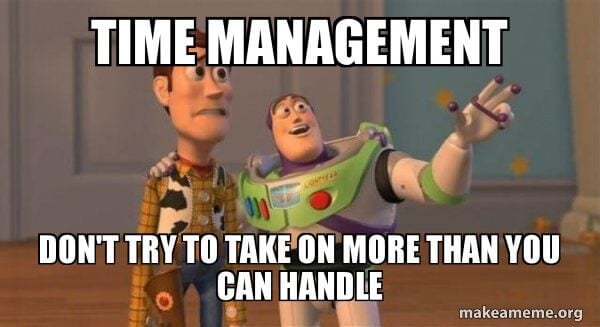When you’re an employer who values your employees, you want them to feel engaged at work. Meanwhile, the more productive the team is, the more time and money you can save.
But we’re all human. No matter how hard we work, irritating barriers can still get in the way of productivity. From the constant pinging of desktop notifications to the occasional meetings that drag on for hours, a lot of things can slow your team down.
So to help you keep everyone (and everything) on track, we’ve compiled a list of productivity hacks that can boost your team’s performance—and it all starts with understanding how much focus the human brain can actually handle.
Understanding the Brain’s Ability to Focus
The average length of time most humans can stay focused on a task is somewhere between 10 and 50 minutes. Everyone’s brain has a different comfort zone within this range, of course, and different tasks require variable amounts of brainpower.
Typically, the more brain power a task takes, the less time a person can focus on it at once.
It’s like sprinting; few of us can engage in a full-on sprint for over a minute—and most of us can’t even do that.
Similarly, even though we’re not deciding to exercise any muscles when we use our brains to think, we’re burning energy nonetheless. In fact, the brain takes up 20% of the body’s metabolic energy every day. In other words, just thinking throughout the day (and night) can burn around 300, 400, or even 500 calories, depending on your metabolism.
However, periods of intense focus can spend up to 5% more of your body’s overall energy budget, and when you try to sustain your focus for too long, productivity suffers.
This means the brain’s energy can and will reach a peak, so sustaining a high level of effort and focus is inherently difficult—because, at some point, you stop focusing on the task at hand and start focusing on trying to stay focused.
It’s no surprise, then, that the average office worker only produces meaningful work for about three total hours in an eight-hour workday.
Nevertheless, there are tips and tricks out there to pump those numbers up by keeping our brains fresh and fueled throughout the day.
7 Ways to Increase Team Productivity
1. Encourage your Team to take More Breaks
Nearly half of workers never take a dedicated break during their workdays — and it’s actually making them less productive, according to a new survey from Slack. Those who do take breaks scored 13% higher for productivity than those who don’t – and 62% higher for work-life balance

Before you look at how to increase productivity, think about how to leverage more time with better ways of working.
One of those ways is to take more breaks. It sounds counterproductive at first, but all sorts of studies have shown that working in bursts is more effective than trying to stay focused on a single project for hours at a time.
That’s why sprint-work systems like the Pomodoro Technique are so popular among students. Meanwhile, employers and employees can get just as much out of it as anyone else.
Here’s how it can work for you and your team:
- Choose an activity. Identify a project or task to work on.
- Set a timer for 25 minutes. Work hard on the activity and avoid distractions during this time.
- Take a five-minute break. When the timer rings, take a break to stretch, doodle, eat a snack, read a book, or chat with co-workers.
- Repeat the previous steps four times. Return to the activity and do four more rounds of 25-minute work sessions with 5-minute breaks.
- Take a 30-minute break. After you complete four intervals, take a longer break.
- Repeat intervals throughout the workday. See how many intervals you can complete in one day.
The Flowtime Technique, for instance, honors the creative flow by allowing you to find your natural work sprint and rest needs. It starts the same way by choosing a task, but instead of setting a 25-minute timer like the Pomodoro, you start a stopwatch and get to work.
As soon as you notice that your brain is getting tired or you’re getting distracted, pause the stopwatch and write down how much time has passed. Use this timeframe to guide your intervals going forward.
If you worked for 25 minutes, then the 5-minute Pomodoro breaks are probably good for you. If you find yourself doing 26 to 50-minute work sprints, those may warrant an eight or 10-minute break. And if you’re able to stay focused between 50 and 90 minutes, try a 10 or 15-minute break.
These periods of downtime give your noggin some time to refresh itself and prepare for the next work interval.
You can encourage your employees to figure out which technique works best for them—and then provide the tools they need to succeed.
2. Make Social Time a Priority
Humans are social creatures. Sure, some of us have higher social needs than others, but science clearly outlines the benefits of social connections. They bring improved health, decreased loneliness, and resilience in the face of stress.
These benefits will also translate into happier employees if given the chance.
Here’s how you can cultivate a sense of community in your workplace, whether it’s remote, hybrid, or in-person:
- Encourage socialization during breaks. Effective team communication matters whether it’s work-related or not. When your employees are taking breaks, they should feel free to talk to each other about anything under the sun. Individual work concerns, personal stuff—whatever they’re comfortable with. If your workplace is remote, you can provide socialization opportunities on platforms like Slack.
- Give employees permission to have fun. Some workplaces require employees to do more physical than mental labor. Examples include jobs in retail, some healthcare settings, and construction. While there may be less room for a Pomodoro-style method of taking breaks in these areas, you can still encourage your employees to have fun and socialize throughout the day. This can help a team bond and put in extra effort as they work together toward common goals.
- Celebrate birthdays and milestones together. Depending on the size of your team, making time each month to honor individual or grouped birthdays and milestones can improve morale and camaraderie. For example, November birthdays could be celebrated at the end of the month during a paid hour of laughter, fun, and delicious food catered by you. These efforts help your employees feel supported and cared for—without stealing any break or work time.
These are only a few generic suggestions, but you can come up with unique ways for your team to socialize as well. Just remember to help everyone feel safe, supported, and content in the workplace.
3. Transform your meetings
One thing that can significantly affect your employees’ focus and workflow is unnecessary meetings. Meetings that don’t necessarily accomplish that much and don’t have a clear purpose should be avoided at all costs. This type of meeting might make your employees feel like their time isn’t being valued and could lead to frustration.
Instead of spending hours in unnecessary meetings, try to keep the whole team informed about the tasks they need to accomplish and their deadlines through emails or messaging apps like Slack. This way, you can keep track of everyone’s tasks without having to interrupt their workflow.
4. Limit overtime
Productivity guru Tim Ferriss states productivity isn’t about packing more into less time. It’s about working better which means understanding;
- Pareto’s Law (aka the 80/20 principle), which says that 80% of results come from 20% of the effort. This means if you can figure out which 20% is producing the results, and then only focus on those actions, you’re overall effectveness will go through the stratosphere. The law also highlights the difference between being effective by doing things that matter and efficient by doing anything (that may or may not matter) well.
- Parkinson’s Law, which says that work expands to fill the time available, so one should never work without explicit time boundaries.
This means if you want your team to be productive, you need a few key elements in place;
You need team members to be focusing on the 20% of activities which bring 80% of the results AND you need to give deadlines and limit hours so that they come back ready and charged for work EVERY time.
Just because someone is working 12 to 16 hours a day, doesn’t mean that they’re effective or productive.
Give your team, and yourself, set hours in which to work and make switching off a priority. You’re likely to see a host of benefits including increased efficiency, greater ideation and better employee engagement and morale.
5. Invest in Technology
Few things make people more frustrated than a broken printer right before a critical deadline or an interactive whiteboard that refuses to connect to Wi-Fi during a presentation.
You can prevent the lion’s share of these frustrating, productivity-killing issues by ensuring that your team’s computers, VoIP and other essential software are always up-to-date—and whatever you spend on IT consulting fees will be well worth it for the productivity losses you’ll end up avoiding.
Similarly, another way to increase productivity in your company is to invest in tools and technology that can assist your employees with their tasks. This can include software, cloud computing services, and other collaboration tools that can make their jobs easier to do.
By using Whale, for example, team members can connect to their work whenever and wherever they need it—thus decreasing disruption and increasing productivity.
6. Create a PTO-Positive Culture
Short breaks during the workday are important for productivity. But paid vacations are, too.
Research suggests that a long vacation or shorter chunks of time off throughout the year come with a slew of benefits.
Of course, time off helps refresh creativity and gives the brain a rest from the demands of the workplace, but it also helps people balance their work with their personal lives. And since PTO is paid, employees don’t have to worry about losing money in order to take a much-needed break.
But here’s the kicker: almost half of the American workforce avoids using all of its available PTO.
Many employees avoid taking all their allotted days off because they feel judged for leaving during a busy time. Others feel nothing but dread at the idea of leaving work only to come back to a giant pile of things to catch up on. Some do it for both reasons.
As an employer, you might secretly think that this is a benefit to your company—after all, when someone doesn’t take PTO, you get to benefit from uninterrupted labor. Sure, this can be good in the short term, but if employees aren’t using their PTO, then they’re at risk of burning out in the long term.
Burnout is bad for a person’s health, and it’s also bad for your business. Burned-out employees are less productive, less focused, and more prone to making mistakes than their well-rested peers.
Thus, try to make it a point to encourage your team members to take their PTO.
You can support your employees by spreading out the workload or helping them wrap up tasks before a vacation so they can take PTO in peace. We also suggest sending out notifications each month that show each employee their PTO balance. This helps keep healthy breaks at the top of your team’s mind.
7. Give opportunities for learning and growth
Another simple but effective way of increasing productivity in the workplace is by offering your employees opportunities for growth.
eLearning Industry reported the following: “A study conducted by the American Society for Training & Development compared two corporate groups, where one company spent nearly three times as much as the other on organization training, and the results were startling. The group that invested more recorded a 57% increase in sales and a 37% rise in gross profit per employee. This clearly highlights the importance of investing in training and development to ensure high productivity and effective returns.”
Bottom line? Focus on the team to improve Productivity
Gallup found that highly engaged teams, comprised of workers whose well-being is valued, show 21% greater profitability and lower rates of employee turnover.
This means focusing on your team members is not just good for your team but good for you.
If you succeed, it won’t take long for your employees to feel valued, appreciated, and respected as both colleagues and as individuals outside of work.
Meanwhile, inside of work, the increase in productivity just might blow you away.

Readiness to Scale Assessment
Almost everyone wants to scale their business but where to start? Take our Readiness to Scale Assessment to find out! You’ll be presented with 10 statements that correlate to one of three specific scaling stages in business.

Bernard San Juan III is the Managing Partner of Truelogic; A digital marketing provider driving progress for businesses to thrive in the ever-evolving digital marketing space.









